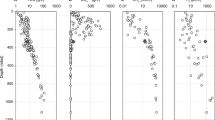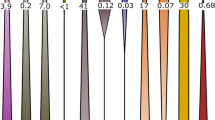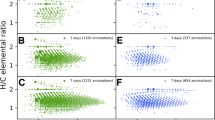Abstract
Among prokaryotes, the large vacuolated marine sulphur bacteria are unique in their ability to store, transport and metabolize significant quantities of sulphur, nitrogen, phosphorus and carbon compounds. In this study, unresolved questions of metabolism, storage management and behaviour were addressed in laboratory experiments with Thioploca species collected on the continental shelf off Chile. The Thioploca cells had an aerobic metabolism with a potential oxygen uptake rate of 1760 μmol O2 per dm3 biovolume per h, equivalent to 4.4 nmol O2 per min per mg protein. When high ambient sulphide concentrations (∼200 μM) were present, a sulphide uptake of 6220±2230 μmol H2S per dm3 per h, (mean±s.e.m., n=4) was measured. This sulphide uptake rate was six times higher than the oxidation rate of elemental sulphur by oxygen or nitrate, thus indicating a rapid sulphur accumulation by Thioploca. Thioploca reduce nitrate to ammonium and we found that dinitrogen was not produced, neither through denitrification nor through anammox activity. Unexpectedly, polyphosphate storage was not detectable by microautoradiography in physiological assays or by staining and microscopy. Carbon dioxide fixation increased when nitrate and nitrite were externally available and when organic carbon was added to incubations. Sulphide addition did not increase carbon dioxide fixation, indicating that Thioploca use excess of sulphide to rapidly accumulate sulphur rather than to accelerate growth. This is interpreted as an adaptation to infrequent high sulphate reduction rates in the seabed. The physiology and behaviour of Thioploca are summarized and the adaptations to an environment, dominated by infrequent oxygen availability and periods of high sulphide abundance, are discussed.
Similar content being viewed by others
Log in or create a free account to read this content
Gain free access to this article, as well as selected content from this journal and more on nature.com
or
References
Ahmad A, Kalanetra KM, Nelson DC . (2006). Cultivated Beggiatoa spp. define the phylogenetic root of morphologically diverse, noncultured, vacuolate sulfur bacteria. Can J Microbiol 52: 591–598.
Andersen K, Kjær T, Revsbech NP . (2001). An oxygen insensitive microsensor for nitrous oxide. Sens Actuators B Chem 81: 42–48.
Arning ET, Birgel D, Schulz-Vogt HN, Holmkvist L, Jørgensen BB, Larson A et al. (2008). Lipid biomarker patterns of phosphogenic sediments from upwelling regions. Geomicrobiol J 25: 69–82.
Bernhard JM, Buck KR . (2004). Eukaryotes of soledad, cariaco and santa barbara basins: protists and metazoans associated with deep-water marine sulfid-oxidizing microbial mats and their possible effects on the geologic record. In: Amend JP, Edwards KJ, Lyons TW (eds). Sulfur Biogeochemistry—Past and Present, vol. 379, Special paper GSA. Geological Society of America: Boulder, CO, pp 35–47.
Cline JD . (1969). Spectrophotometric determination of hydrogen sulfide in natural waters. Limnol Oceanogr 14: 454–458.
Crank J . (1983). The mathematics of diffusion. Oxford University Press, London.
de Beer D, Sauter E, Niemann H, Kaul N, Foucher JP, Witte U et al. (2006). In situ fluxes and zonation of microbial activity in surface sediments of the Hakon Mosby Mud Volcano. Limnol Oceanogr 51: 1315–1331.
Ferdelman TG, Lee C, Pantoja S, Harder J, Bebout BM, Fossing H . (1997). Sulfate reduction and methanogenesis in a Thioploca-dominated sediment off the coast of Chile. Geochim Cosmochim Acta 61: 3065–3079.
Fossing H, Gallardo VA, Jørgensen BB, Huttel M, Nielsen LP, Schulz H et al. (1995). Concentration and transport of nitrate by the mat-forming sulfur bacterium Thioploca. Nature 374: 713–715.
Gallardo VA . (1963). Notas sobre la densidad de la fauna bentónica en el sublittoral del norte de Chile. Gayana (Zool) 10: 3–15.
Gallardo VA . (1977a). Large benthic microbial communities in sulphide biota under Peru-Chile Subsurface Cuntercurrent. Nature 268: 331–333.
Gallardo VA . (1977b). On the discovery of a large microbial community living in the soft bottoms of the continental shelf off Chile and Peru. Anales Inst Invest Marinas Pta Betín Colombia Supl 1: 23–30.
Gallardo VA, Espinoza C . (2007a). New communities of large filamentous sulfur bacteria in the eastern South Pacific. Int Microbiol 10: 97–102.
Gallardo VA, Espinoza C . (2007b). Large multicellular filamentous bacteria under the oxygen minimum zone of the eastern South Pacific: a forgotten biosphere. In: Richard BH, Gilbert VL, Alexei YR, Paul CWD (eds). Instruments, Methods, and Missions for Astrobiology, vol. 6694. Procof SPIE: Bellingham, USA, pp 1H–11H.
Grasshoff K, Kremling K, Ehrhardt M . (1999). Methods of Seawater Analysis. Wiley: New York.
Gray ND, Head IM . (2005). Minerals, mats, pearls and veils: themes and variations in giant sulphur bacteria. In: Gadd GM, Semple KT, Lappin-Scott (eds). Micro-Organisms and Earth Systems. Cambridge University Press: Cambridge, pp 35–70.
Hershey JP, Plese T, Millero FJ . (1988). The Pk1-star for the dissociation of H2S in various ionic media. Geochim Cosmochim Acta 52: 2047–2051.
Hesselsø M, Nielsen JL, Roslev P, Nielsen PH . (2005). Isotope labeling and microautoradiography of active heterotrophic bacteria on the basis of assimilation of 14CO2 . Appl Environ Microbiol 71: 646–655.
Høgslund S, Revsbech NP, Cedhagen T, Nielsen LP, Gallardo VA . (2008). Denitrification, nitrate turnover and aerobe respiration by benthic foraminifera in the oxygen minimum zone off Chile. J Exp Mar Bio Ecol 359: 85–91.
Huettel M, Forster S, Kloser S, Fossing H . (1996). Vertical migration in the sediment-dwelling sulfur bacteria Thioploca spp in overcoming diffusion limitations. Appl Environ Microbiol 62: 1863–1872.
Jørgensen BB, Nelson DC . (2004). Sulfide oxidation in marine sediments: geochemistry meets microbiology. In: Amend JP, Edwards K, Lyons TW (eds). Sulfur Biogeochemistry—Past and Present vol. 379. Special paper GSA, pp 63–81.
Jørgensen BB, Revsbech NP . (1983). Colorless sulfur bacteria, Beggiatoa spp and Thiovulum spp in O2 and H2S microgradients. Appl Environ Microbiol 45: 1261–1270.
Jørgensen BB, Teske A, Ahmad A . (2005). Thioploca. In: Krieg NR, Staley JT, Brenner DJ (eds). Bergey's Manual of Systematic Bacteriology, vol. 2. pp 171–178.
Kalanetra KM, Huston SL, Nelson DC . (2004). Novel, attached, sulfur-oxidizing bacteria at shallow hydrothermal vents possess vacuoles not involved in respiratory nitrate accumulation. Appl Environ Microbiol 70: 7487–7496.
Kuhl M, Steuckart C, Eickert G, Jeroschewski P . (1998). A H2S microsensor for profiling biofilms and sediments: application in an acidic lake sediment. Aquat Microb Ecol 15: 201–209.
Maier S, Gallardo VA . (1984a). Thioploca araucae sp. nov. and Thioploca chileae sp. nov. Int J Syst Microbiol 34: 414–418.
Maier S, Gallardo VA . (1984b). Nutritional characteristics of two marine Thioplocas determined by autoradiography. Arch Microbiol 139: 218–220.
McHatton SC, Barry JP, Jannasch HW, Nelson DC . (1996). High nitrate concentrations in vacuolate, autotrophic marine Beggiatoa spp. Appl Environ Microbiol 62: 954–958.
Møller MM, Nielsen LP, Jørgensen BB . (1985). Oxygen responses and mat formation by Beggiatoa spp. Appl Environ Microbiol 50: 373–382.
Murphy J, Riley JP . (1962). A modified single solution method for determination of phosphate in natural waters. Anal Chem Acta 26: 31–35.
Mussmann M, Hu FZ, Richter M, de Beer D, Preisler A, Jørgensen BB et al. (2007). Insights into the genome of large sulfur bacteria revealed by analysis of single filaments. PLoS Biol 5: 1923–1937.
Mussmann M, Schulz HN, Strotmann B, Kjær T, Nielsen LP, Rossello-Mora RA et al. (2003). Phylogeny and distribution of nitrate-storing Beggiatoa spp. in coastal marine sediments. Environ Microbiol 5: 523–533.
Nelson DC, Jørgensen BB, Revsbech NP . (1986a). Growth-pattern and yield of a chemoautotrophic Beggiatoa sp in oxygen-sulfide microgradients. Appl Environ Microbiol 52: 225–233.
Nelson DC, Revsbech NP, Jørgensen BB . (1986b). Microoxic-anoxic niche of Beggiatoa spp-Microelectrode survey of marine and fresh-water strains. Appl Environ Microbiol 52: 161–168.
Nielsen JL, Nielsen PH . (2005). Advances in microscopy: microautoradiography of single cells. Methods Enzymol 397: 237–246.
Otte S, Kuenen JG, Nielsen LP, Paerl HW, Zopfi J, Schulz HN et al. (1999). Nitrogen, carbon, and sulfur metabolism in natural Thioploca samples. Appl Environ Microbiol 65: 3148–3157.
Papadopulos F, Spinelli M, Valente S, Foroni L, Orrico C, Alviano F et al. (2007). Common tasks in microscopic and ultrastructural image analysis using ImageJ. Ultrastruct Pathol 31: 401–407.
Preisler A, de Beer D, Lichtschlag A, Lavik G, Boetius A, Jørgensen BB . (2007). Biological and chemical sulfide oxidation in a Beggiatoa inhabited marine sediment. ISME J 1: 341–353.
Prokopenko MG, Hammond DE, Berelson WM, Bernhard JM, Stott L, Douglas R . (2006). Nitrogen cycling in the sediments of Santa Barbara basin and Eastern Subtropical North Pacific: nitrogen isotopes, diagenesis and possible chemosymbiosis between two lithotrophs (Thioploca and Anammox)-“riding on a glider”. Earth Planet Sci Lett 242: 186–204.
Revsbech NP . (1989). An oxygen microsensor with a guard cathode. Limnol Oceanogr 34: 474–478.
Revsbech NP, Jørgensen BB . (1986). Microelectrodes—their use in microbial ecology. Adv Microb Ecol 9: 293–352.
Sayama M . (2001). Presence of nitrate-accumulating sulfur bacteria and their influence on nitrogen cycling in a shallow coastal marine sediment. Appl Environ Microbiol 67: 3481–3487.
Sayama M, Risgaard-Petersen N, Nielsen LP, Fossing H, Christensen PB . (2005). Impact of bacterial NO3− transport on sediment biogeochemistry. Appl Environ Microbiol 71: 7575–7577.
Schmaljohann R, Drews M, Walter S, Linke P, von Rad U, Imhoff JF . (2001). Oxygen-minimum zone sediments in the northeastern Arabian Sea off Pakistan: a habitat for the bacterium Thioploca. Mar Ecol Prog Ser 220: 295–295.
Schulz HN, Brinkhoff T, Ferdelman TG, Marine MH, Teske A . (1999). Dense populations of a gigant sulfur bacterium in Namibian shelf sediments. Science 284: 493–495.
Schulz HN, de Beer D . (2002). Uptake rates of oxygen and sulfide measured with individual Thiomargarita namibiensis cells by using microelectrodes. Appl Environ Microbiol 68: 5746–5749.
Schulz HN, Jørgensen BB . (2001). Big bacteria. Annu Rev Microbiol 55: 105–137.
Schulz HN, Jørgensen BB, Fossing HA, Ramsing NB . (1996). Community structure of filamentous, sheath-building sulfur bacteria, Thioploca spp, off the coast of Chile. Appl Environ Microbiol 62: 1855–1862.
Schulz HN, Schulz HD . (2005). Large sulfur bacteria and the formation of phosphorite. Science 307: 416–418.
Schulz HN, Strotmann B, Gallardo VA, Jørgensen BB . (2000). Population study of the filamentous sulfur bacteria Thioploca spp. off the Bay of Concepcion, Chile. Mar Ecol Prog Ser 200: 117–126.
Smith MS, Firestone MK, Tiedje JM . (1978). Acetylene inhibition method for short-term measurement of soil denitrification and its evaluation using N-13. Soil Sci Soc Am J 42: 611–615.
Sten-Knudsen O . (2002). Biological Membranes, Theory of Transport, Potentials and Electrical impulsesa. Cambridge University press: Cambridge.
Strohm TJ, Griffin B, Zumft WG, Schink B . (2007). Growth yields in bacterial denitrification and nitrate ammonification. Appl Environ Microbiol 73: 1420–1424.
Sweerts J, Debeer D, Nielsen LP, Verdouw H, Vandenheuvel JC, Cohen Y et al. (1990). Denitrification by sulfur oxidizing Beggiatoa Spp. mats on fresh-water sediments. Nature 344: 762–763.
Teske A, Ramsing NB, Kuver J, Fossing H . (1996). Phylogeny of Thioploca and related filamentous sulfide-oxidizing bacteria. Syst Appl Microbiol 18: 517–526.
Thamdrup B, Canfield DE . (1996). Pathways of carbon oxidation in continental margin sediments off central Chile. Limnol Oceanogr 41: 1629–1650.
Zopfi J, Kjær T, Nielsen LP, Jørgensen BB . (2001). Ecology of Thioploca spp.: nitrate and sulfur storage in relation to chemical microgradients and influence of Thioploca spp. on the sedimentary nitrogen cycle. Appl Environ Microbiol 67: 5530–5537.
Acknowledgements
We thank all participants on the 2006 Thioploca-Chile Expedition for their scientific support. We also thank the staff of Dichato Marine Biological Station and the crew of R/V Kay Kay of the University of Concepción for their help and hospitality. This work was supported by the Max Planck Society and the Danish Natural Science Research Council Grants 21-03-0500 and 272-06-0504 and the Department of Oceanography of the University of Concepción, Census of Marine Life Program, and FONDECYT Project no. 1070552 to VAG.
Author information
Authors and Affiliations
Corresponding author
Rights and permissions
About this article
Cite this article
Høgslund, S., Revsbech, N., Kuenen, J. et al. Physiology and behaviour of marine Thioploca. ISME J 3, 647–657 (2009). https://doi.org/10.1038/ismej.2009.17
Received:
Revised:
Accepted:
Published:
Issue date:
DOI: https://doi.org/10.1038/ismej.2009.17
Keywords
This article is cited by
-
Time-series transcriptomics from cold, oxic subseafloor crustal fluids reveals a motile, mixotrophic microbial community
The ISME Journal (2021)
-
Sedimentary pyrite sulfur isotopes track the local dynamics of the Peruvian oxygen minimum zone
Nature Communications (2021)
-
Effects of Ferrous Iron and Hydrogen Sulfide on Nitrate Reduction in the Sediments of an Estuary Experiencing Hypoxia
Estuaries and Coasts (2021)
-
Nitrogen losses in anoxic marine sediments driven by Thioploca–anammox bacterial consortia
Nature (2013)
-
Diversity of Freshwater Thioploca Species and Their Specific Association with Filamentous Bacteria of the Phylum Chloroflexi
Microbial Ecology (2011)



